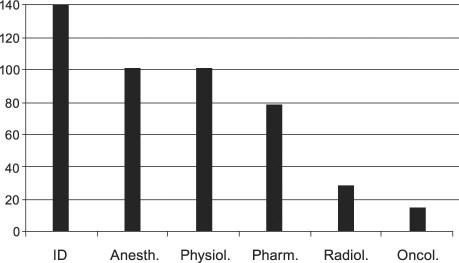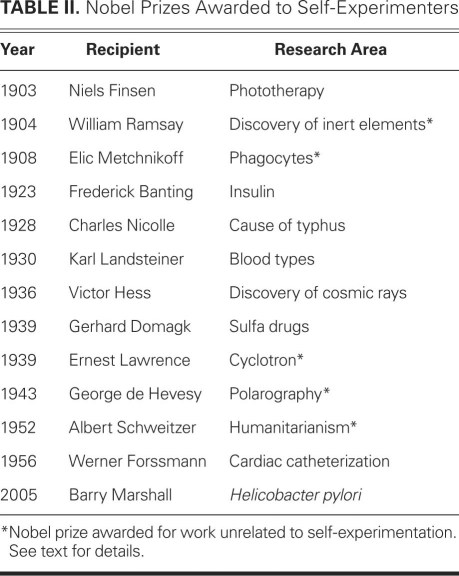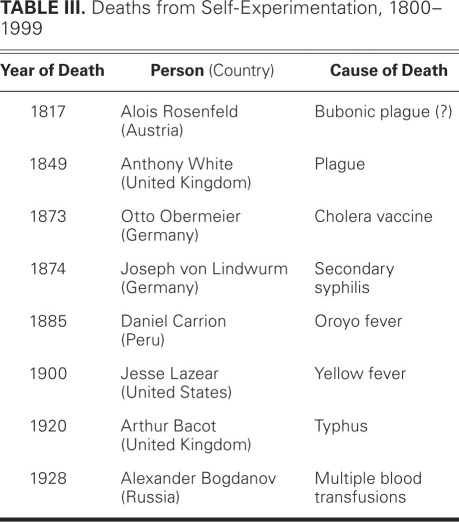Abstract
Although experimentation involving human volunteers has attracted intense study, the matter of self-experimentation among medical researchers has received much less attention. Many questions have been answered only in part, or have been left unanswered. How common is this practice? Is it more common among certain nationalities? What have been the predominant medical fields in which self-experimentation has occurred? How dangerous an act has this proved to be? What have been the trends over time? What is the future likely to bring?
From the available literature, I identified and analyzed 465 documented instances of this practice, performed over the course of the past 2 centuries. Most instances occurred in the United States. The peak of self-experimentation occurred in the first half of the 20th century. Eight deaths were recorded. A number of the investigators enjoyed successful careers, including the receipt of Nobel Prizes. Although self-experimentation by physicians and other biological scientists appears to be in decline, the courage of those involved and the benefits to society cannot be denied.
Key words: Ethics, research/history; history, 19th century; history, 20th century; human research; medical discovery; medical ethics; self-experimentation
The medical literature of the last half century or more abounds with reports of malpractice and misadventure in the form of experiments involving patients and other susceptible groups, such as the poor, students, convicts, and victims of the Holocaust; yet little has been written about self-experimentation and even less about the need to curtail it—for better or for worse.
For the general public and for most doctors, I suspect, the first thing to come to mind when self-experimentation is mentioned is Walter Reed's Yellow Fever Commission in Cuba in 1900 and its plan to allow mosquitoes suspected of harboring the deadly disease to bite Commission members, thus to demonstrate the mode of transmission. The ensuing public recognition of Reed above that of his colleagues is ironic, because Reed left for Washington, D.C., on the day after the pact was made and never himself submitted to the experiment. James Carroll was bitten and developed yellow fever, the consequence of which was chronic ill health for the rest of his life. Also bitten was Jesse Lazear, who died of the disease. The fourth member of the commission, Aristides Agramonte, was excluded from the experiment because he had recovered from a bout of yellow fever and was assumed to have acquired immunity.1
The yellow fever experiment is often presented as a heroic episode in medicine, although some will argue that it was more foolhardy than heroic. Perhaps there are elements of both in such ventures.
In contrast to the experience of the Reed Commission, the overwhelming majority of medical self-experiments have been performed by single individuals in relative isolation, and not by a committee acting under fiat. The first truly systematic study of self-experimentation, to the best of my knowledge, appeared in Lawrence Altman's book Who Goes First?, published in 1987.2 In this work, Altman artfully recorded over a hundred examples of this practice. A more recent source, Arsen Fiks's Self Experimenters: Sources for Study 3 (2003), contains several hundred additional examples of self-experimentation. The title of the book is quite explicit, for Fiks does not provide details or interpretations: he simply lists names, dates, and very brief descriptions of procedures and outcomes.
From these 2 sources, I extracted 514 examples of this practice. In order to determine trends over time, I discarded the 49 examples antedating 1800 and divided, into 50-year time periods, the remaining 465 episodes that occurred over the next 2 centuries. The areas of interest comprised 6 categories: infectious diseases (including vaccines), anesthesiology (general and local), physiology, pharmacology, radiology (including x-rays and other radiation sources), and oncology. The representation of each over the entire 2 centuries is illustrated in Figure 1. Infectious diseases is the most strongly represented, followed by anesthesiology, physiology, and pharmacology, with radiology and oncology at the lower end.
Fig. 1 Categories of the 465 instances of self-experimentation, 1800–1999. Anesth. = anesthesia; ID = infectious diseases; Oncol. = oncology; Pharm. = pharmacology; Physiol. = physiology; Radiol. = radiology
Table I shows a more detailed breakdown over the four 50-year periods. For some categories, the influence of the medical trends of a particular time is mirrored in the results. In anesthesiology, for example, the introduction of general anesthesia in the 1830s and 1840s, followed by the adoption of local anesthesia during the 1880s, is reflected by a sizable number of self-experiments during the first two 50-year periods. As these anesthetic methods were absorbed into standard medical practice, the number of self-experiments in the field fell off sharply. Roentgen did not discover x-rays until 1895, and the Curies did not isolate radium until 1902. Unsurprisingly, there were no instances of self-experimentation along these lines until the third 50-year period, when a flurry of such instances occurred. The number fell off sharply in the final period. In contrast to these 2 fields of endeavor, attempts involving infectious diseases, pharmacology, and physiology are well represented over the entire 2 centuries. Surprisingly, attempts at self-experimentation in oncology were few throughout the entire period. The total number of self-experiments peaked at 189 in the first half of the 20th century, falling sharply to 82 during the final period observed.
TABLE I. Changing Trends in Self-Experimentation, 1800–1999
Who Performed This Kind of Research? Given the social and professional strictures of the times, women were in a distinct minority among these self-experimenters. Only 12 women could be identified, 5 of them Russian. What about the nationalities of the group as a whole? The nation most prominently represented was the United States (33% of the total), followed by Germany (15%), the United Kingdom (13%), Russia (11%), and France (8%), with lower representations among countries in the remaining 20%.
Were These Individuals Remarkable in Any Other Way? It turns out that 12 actually received one type of Nobel Prize or another, the most recent one going to Barry Marshall in 2005 after his ingestion of a Helicobacter culture to demonstrate in his own stomach how it might cause gastrointestinal disease (Table II). Five of these Nobel recipients won for work unrelated to their self-experimentation. These were Ramsay, who exposed himself to various gases to determine their anesthetic properties; Metchnikoff, who injected himself with blood containing relapsing fever spirochetes; Lawrence, who drank a solution containing radioactive sodium; de Hevesy, who drank a solution containing heavy water to monitor its elimination from the body; and Schweitzer, who submitted himself to an unproven yellow fever vaccine to determine any side effects.
TABLE II. Nobel Prizes Awarded to Self-Experimenters
How Successful Were These Ventures?
In a remarkable 89% of instances, the self-experiments obtained positive results in support of a hypothesis or valuable data that had been sought. In the remaining studies in which results were either negative or inconclusive, some of the negative results could be viewed as beneficial in directing investigators into more fruitful avenues of research.
At What Cost Were These Results Obtained? Of course the clearest negative endpoint was the death of the scientist as a direct result of his self-experiment. Eight such deaths are indicated in Table III, all but one of them the result of infectious diseases. In the case of Alexander Bogdanov, it seems most likely that what killed him was a severe immunologic reaction to the multiple blood transfusions to which he subjected himself. Although death directly related to the intervention was obvious, there were instances in which a severe acute illness occurred. Then, after initial recovery was noted, long-term disability sometimes ensued. Some delayed effects of experiments involving radioactivity are also worth noting. For example, Marie Curie's death at age 67 from leukemia was almost surely related to her exposure during the course of her career. As mentioned above, James Carroll experienced ill health for the remainder of his life, despite his recovery from an acute attack of yellow fever.
TABLE III. Deaths from Self-Experimentation, 1800–1999
What Has Been the Role of Self-Experimentation in Cardiovascular Disease? Its application in this particular field has been limited in number but enormously important in impact. Some lesser examples include that of Henry C. Bazett, who used himself as a subject in the study of pulse-wave velocity (1921). Hermann Blumgart injected himself with radon in 1927 to study the velocity of blood flow. Waldo E. Cohn performed a similar self-experiment with radioactive sodium about a decade later.
The most dramatic and influential self-experiment in cardiology was that of Werner Forssmann, who, in 1929, inserted a catheter into his own antecubital vein and passed it retrogradely into the right atrium, documenting this achievement by an x-ray of his chest taken at the time.2 Some years earlier, in 1911 and 1912, Fritz Bleichroeder had inserted catheters into peripheral vessels, his own as well as those of others, and claimed to have reached his own heart with the tip of a catheter at one point. However, there was no radiographic documentation of this, which leaves Forssmann's claim to priority unassailable. Together with Dickinson Richards and André Cournand of New York, who popularized the technique in the early 1940s, Forssmann received the Nobel Prize in Medicine or Physiology in 1956.
Fiks lists others who later subjected themselves to cardiac catheterization in pursuit of their research: Robert A. Bruce, Howard B. Burchell, and Eugene Stead. He mistakenly includes Cournand, who, much to his personal chagrin and regret, never offered himself as a subject.2 As I looked further into the history of heart catheterization, specifically in the context of self-experimentation, I learned that Fiks overlooked several other individuals. At the Mayo Clinic, not only did Burchell undergo voluntary heart catheterization, but Drs. H.F. “Fred” Helmholz and Earl H. Wood did so as well.* Stead's paper4 mentions another physician volunteer, in addition to himself, but that person is not further identified.
I recalled my own entry into the field of cardiovascular research as a fellow at the University of Utah School of Medicine (1961–1963). While there, I gained the impression that a number of senior cardiologists, in setting up their laboratories, also had undergone cardiac catheterization. I suspected that, at some laboratories, this might even have been a rite of passage for tyros such as I, although this period was at least a decade or more before my time. What was going on here?
For a better understanding of the ethics involved, I turned to the field of immunology and the development of vaccines. In Saul Benison's oral-history memoir of the curmudgeonly Tom Rivers, a leading virologist at the Rockefeller Foundation from 1922 through 1955, I found the quotation I sought: “I know that if anyone ever came up to me and asked me to take an untried vaccine, I'd ask ‘Have you taken it?’ and, by God, if that person said ‘No,’ I'd tell him to go to hell.”5
To confirm the safety of their products, the developers of vaccines were expected to subject not only themselves to inoculation, but their immediate personal and professional families. Rivers noted that Salk administered his vaccine to himself and to his wife and children, before field trials were begun. Similarly, Albert B. Sabin, father of the oral polio vaccine, administered it to his wife and daughters, as well as to their playmates, before administering it to hundreds and then thousands of others in field trial.*
In essence, therefore, it is probable that many cardiologists of the time, with no public fanfare, had themselves catheterized as they set up their hemodynamic laboratories. One stated reason for this was the need to obtain normal values for use of the newly established facilities. However, I believe they also did so to assure themselves and others of the safety of the procedure—a case of developing a familiarity that would breed not contempt, but con-tent. This attitude was still probably alive and well in more recent times. When Andreas Gruentzig introduced coronary angioplasty at Emory University's medical school in 1980, he himself underwent coronary arteriography to demonstrate to his new chief his belief in the safety of the procedure.** Such revelations engender in me, perhaps anachronistically, the feeling of camaraderie that one experiences in contributing to a research enterprise and in partaking, even a little, in the adventure of discovery.
What is the current status of self-experimentation and what might its role be in the future? Will there be any efforts to restrain or regulate this activity? In preparation for this article, I sent letters of inquiry to a number of authors who had published on the subject of human experimentation, but no new information was forthcoming.
Occasional conferences, such as that at the Harvard School of Public Health in 2004, are held to discuss the pros and cons of self-experimentation. Aside from my discovery that some institutional review boards might not approve any research proposals involving this practice, I have learned of no other new guidelines or regulations that have emerged from such conferences. I wrote to the U.S. Food and Drug Administration (FDA), the National Institutes of Health, and the Institute of Medicine, also without success.
Surely those pharmaceutical giants responsible for the preparation and introduction of vaccines might have something to offer, I thought. My letter to Novartis was answered by a detailed reply, which assured me that, for all their products, the company followed strict FDA guidelines, informed-consent procedures, and institutional review board oversight, including the close monitoring of any clinical activity.***
The trend in recent years toward collaborative studies, often on a massive scale, makes self-experimentation by a single individual, tucked away in his laboratory, seem almost quaint, a relic of the past. However, advances in medicine are not often made by panels of recognized “experts.” Rivers5 has called this “gang or group research.” He goes on to say, “Great discoveries are not made by committees or groups of workers; they originate in the minds of single individuals … I know of no important discovery in medicine or biology in the last hundred years that evolved out of gang research. You can do a hell of a lot of scut work by gang research, but the ideas for discovery are still going to come from the ideas in one man's mind. In other words, you can hire men but not ideas.”
Perhaps as we progress into a new era of molecular biology, which is characterized by the development of increasingly complex methods of research, the need for self-experimentation will vanish. My own conclusion is that, despite some unwise decisions in the past to indulge in this activity, many self-experiments have proved invaluable to the medical community and to the patients we are seeking to help. Therefore, rather than scorn such intrepid colleagues in their search for truth, I am inclined to salute them.
Footnotes
*Interview with Dr. Sabin by ABW, 27 July 1987.
**Personal communication (e-mail) from J. Willis Hurst to ABW, 27 February 2011.
***Letter from Clement Lewin (of Novartis) to ABW, 23 July 2010.
Address for reprints: Allen B. Weisse, MD, 164 Hillside Ave., Springfield, NJ 07081
E-mail: weisseab@umdnj.edu
References
- 1.Bryan CS. Gloria in absentia: Walter Reed, James Carroll, and the ethics of authorship. Pharos Alpha Omega Alpha Honor Med Soc 2006;69(4):16–22. [PubMed]
- 2.Altman LK. Who goes first? The story of self-experimentation in medicine. New York: Random House; 1987.
- 3.Fiks AP. Self-experimenters: sources for study. Westport (CT): Praeger Publishers; 2003.
- 4.Stead EA, Warren JV, Merrill AJ, Brannon ES. The cardiac output in male subjects as measured by the technique of right atrial catheterization. Normal values with observations on the effect of anxiety and tilting. J Clin Invest 1945;24(3):326–31. [DOI] [PMC free article] [PubMed]
- 5.Benison S. Tom Rivers. Reflections on a life in medicine and science. An oral history memoir. Cambridge (MA): MIT Press; 1967. p. 545, p. 424.






